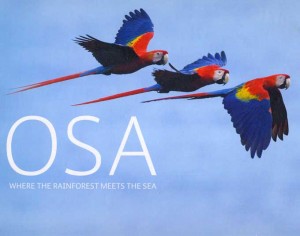Osa On My Mind
By Jim Parisi
 It had never crossed my mind that one of the reasons that the Osa Peninsula has remained such pristine terrain is because its isolation has helped it to remain an entity. This geographical logic comes up early in the text of the stunning new book “Osa – Where the Rainforest Meets the Sea”, a successful collage of photographic art and insightful journalistic essays that portray this unique region in southwest Costa Rica like no publication that has preceded it. In fact, two-time Pulitzer Prize winner and Harvard Professor Emeritus Edward O. Wilson proclaimed the work, “the best way to experience (Osa) short of going there.” High accolades, indeed.
It had never crossed my mind that one of the reasons that the Osa Peninsula has remained such pristine terrain is because its isolation has helped it to remain an entity. This geographical logic comes up early in the text of the stunning new book “Osa – Where the Rainforest Meets the Sea”, a successful collage of photographic art and insightful journalistic essays that portray this unique region in southwest Costa Rica like no publication that has preceded it. In fact, two-time Pulitzer Prize winner and Harvard Professor Emeritus Edward O. Wilson proclaimed the work, “the best way to experience (Osa) short of going there.” High accolades, indeed.
The two hundred twenty pages are separated into eleven sections with a forward by internationally renowned biologist, conservationist and nature writer Adrian Forsyth, certainly lending more credence to this two-man project by highly acclaimed nature photographer Roy Toft and writer Trond Larsen. Toft’s work has been featured in National Geographic, Smithsonian, Audubon and Discover Magazine, to name a few. He has been traveling to the Osa Peninsula for more than twenty years. His partner in this book, biologist/conservationist Trond Larsen received his PhD from Princeton and has been conducting scientific research on the Osa for more than a decade, has established a new biological station there and is currently a research fellow with the World Wildlife Federation and the Smithsonian Institute. These are all lovely credentials but honestly, the book speaks for itself and in ways that make the resumes seem inconsequential: it is a masterpiece. The scenery photos are spectacular and the writing is truly heartfelt. And I think it is the wildlife photographs that help to put this project head and shoulders above all others along with the obvious emotion, the care that went into the entire presentation. Trond told me that it took him nearly two years to find time away from his research biologist job to put together his half of the project and that Toft’s photos in the book are a cross section of literally thousands of shots he has taken in the Osa over the past decade or more.
More than fifty years ago, botanist Paul Allen wrote of the Osa that “it is difficult to believe that anyone could view these forests without emotion”. That sentiment emanates from every page of this publication. The staggering wealth of bio-diversity and life there is portrayed both in images and the written word, along with the sense of the delicate balance, the micro-environments and unique situation that exists at Osa. The inter-relationships, dependences, not unlike a woven fabric, are astounding. Trond Larsen has done a highly commendable job of making this information palatable to a lay person, such as me, for example. I have to say that reading the text in this book also has a certain sobering effect, an immediate diminishing of human ego.
The division of information into chapters is also subtly yet well calculated, beginning with a nice overview and history of the peninsula. Four of the chapters are dedicated to the different animal groups in the area: mammals, arthropods, reptiles and amphibians, and birds. Another chapter focuses strictly on the flora, while three other chapters each are immersed in a particular ecosystem: watersheds, the rainforest intersecting with the ocean, and the Golfo Dulce. The final chapter, “The Human Animal”, looks at how we have and will fit into the history of this unique area. The book also dedicates, not surprisingly, one chapter to the importance of conservation. Personally, I think the whole book does a good job of reminding us about this essential topic.
It is important to note that a portion of each sale of this book is donated directly to conservation projects on the Osa Peninsula. The book is available at all three Jaime Peligro book shops in Playa Tamarindo, Tilaran and Quepos, where the customer can view a sample copy of “Osa – Where the Rainforest Meets the Sea”.

